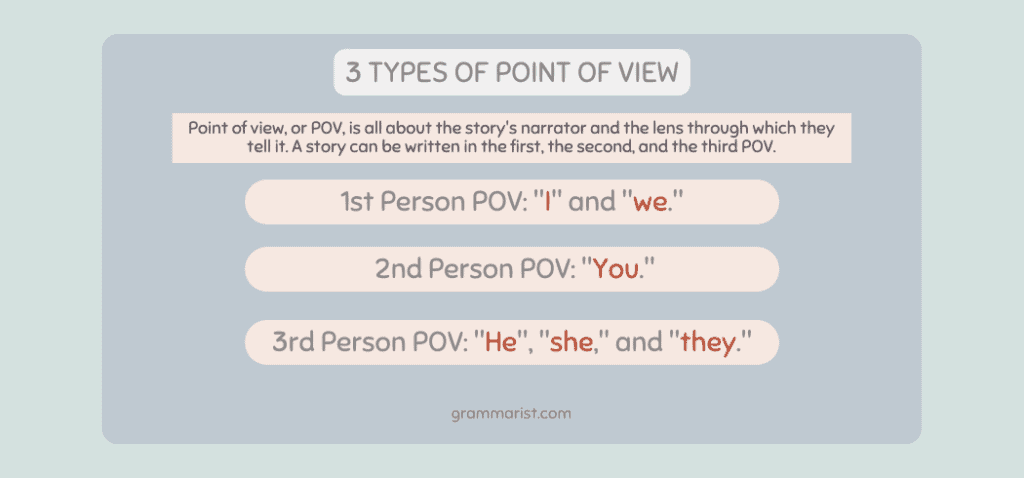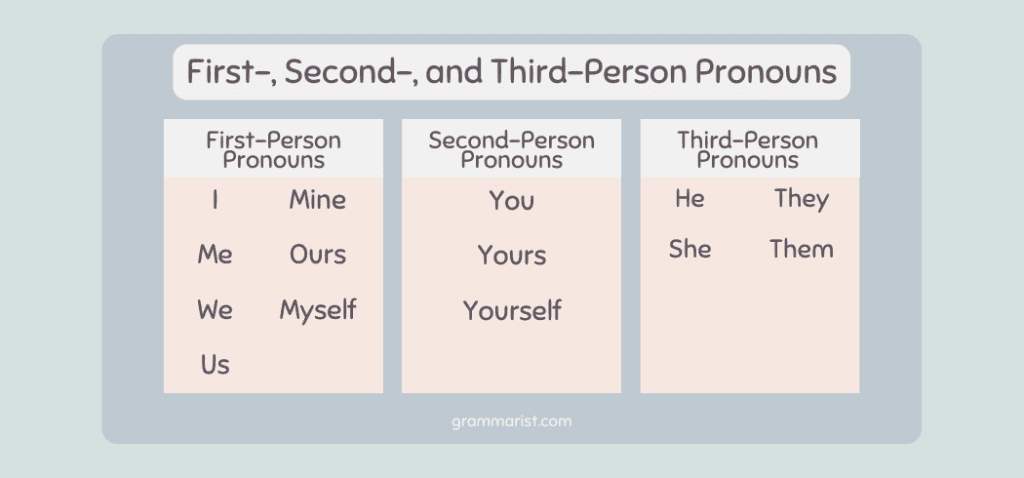Creative writers like me use point of view as the lens through which they relay a narrative. There are three basic perspectives, but there is no right perspective that should be used for a best-seller. I prefer to write and read in first-person POV, but third-person is good, too. Examine the benefits of each point of view to figure out which one you’d like to use in your own writing.
Writing in First, Second, and Third Person POV
By employing pronouns, writers can tell a story from the first person, second person, or third person perspective. These are called points of view. And depending on the mood and tone of the story, you can choose either of these for your narration.
What Are the 3 Types of Point of View?

One of the first choices a writer of fiction must make is the perspective from which the story will be told. Point of view, or POV, is all about the story’s narrator and the lens through which they tell it. A story can be written in the first, the second, and the third POV.
The POV you choose for your story will impact the tone, mood, how the reader connects to the story and the characters, and many other important aspects.
Each of the three main points of view uses a specific set of pronouns. Here is my quick go-to pronoun list to remember:
- The 1st person POV uses “I” and “we.”
- The 2nd person POV uses “you.”
- The 3rd person POV relies on “he,” “she,” and “they.”
Why Are POVs Important?
We know what POVs are, but why is it important to choose the right one in your stories? I get asked this all the time.
They Create Narrative Distance
Distance in fiction, often known as “psychic distance” or “narrative distance,” is a concept first introduced in James Gardner’s The Art of Fiction. Consider how much separation from the story you want to create for the reader. It will affect the mood of your novel, the amount of information given to the reader, and the way the plot progresses.
When a novel deals with heavy emotional themes, it may benefit the author and reader to be on closer psychic terms. However, in other cases, the author may wish to create more “distance” between themselves and the reader to provide a more detached commentary.
For example, I mainly write in first-person because I like to pull in the reader and make them feel as though they are the characters. That’s a close narrative distance. However, I’ve written books in the third person to help round out a story and provide a fuller picture. Kind of like watching a TV show. This is a further narrative distance.
It Hints at the Storytelling Style
How the reader receives the narrative depends on who is doing the telling. Using first- or third-person perspective, we enter a character’s head. The reader will experience not only the character’s feelings and ideas but also their speech and mental patterns. In what ways do they spend their time thinking? Do they usually think in short, snappy words or lengthy discourses?
The employment of a third-person omniscient narrator is preferable in genres that call for extensive exposition or technical information when a limited number of viewpoint characters would be unrealistic.
It Sets the Vibe for the Story
The tone and atmosphere of a story can be drastically altered by the author’s choice of emotional narration. Everyone knows at least one person whose presence can alter the atmosphere in any given place. Narration works similarly; the narrator’s style affects the story’s mood.

First-Person Pronouns
- I
- Me
- Mine
- We
- Us
- Ours
- Myself
Second-Person Pronouns
- You
- Yours
- Yourself
Third-Person Pronouns
- They
- She
- He
- Them
First Person Point of View Examples
Since telling stories in the first person is so natural to us, it’s easy to pick up on when writing. A first-person narrator usually serves as the story’s hero.
The first-person point of view allows us to feel and see what they see by putting us in the shoes of the protagonist or protagonists. It’s no surprise that coming-of-age stories frequently employ this technique in which feelings of despair and loneliness are front and center.
One problem is that stories with only one narrator tend to be less complex than those with multiple narrators. Only the narrator can reveal any information to the reader. Some claim that a first-person narrator is automatically prejudiced, although intentionally unreliable narrators can make for interesting literary works.
When a person is speaking conversationally, he is speaking from the first-person point of view. Some famous novels written in the first-person point of view are The Adventures of Huckleberry Finn by Mark Twain, To Kill a Mockingbird by Harper Lee, and The Outsiders by S. E. Hinton.
Here’s an example of a first-person POV from one of my own works:
I closed my eyes and braced my legs as I worked through calming my breaths. Focusing on the glow that hummed in my veins. A dormant thing, all sleepy and warm. A little too warm. I could already feel the static of magic building in my hands, crackling over the heat.
Second Person Point of View Examples
There are fewer second-person narratives. The objective is to bring the reader into a character’s head, primary or secondary. The biggest reason this point of view isn’t more common is that it asks too much of the reader in terms of belief.
It can give the impression of technical prowess and sophistication when done well. It works best, though, in shorter, more lyrical works (such as poetry) or to inject some diversity into a lengthier narrative written from a different point of view.
When a person writes an email or letter or writes a how-to book, they usually use a second-person point of view. Writing in the second person is very unusual, though the novel Bright Lights, Big City is a successful example. But you’ll mostly see this POV used in academic writing and instructional guides.
The depiction of the second person point of view is even rarer in film, as the characters on screen would have to directly address the audience, making the audience another character in the story.
Third Person Point of View Examples
Popular novels written in the third person point of view are the Harry Potter series by J. K. Rowling, Throne of Glass by Sarah J. Maas, and The Scarlet Letter by Nathaniel Hawthorne. Most films are written in the third person point of view.
The popular third-person point of view can be divided into three other types: omniscient, limited, and objective.
Third Person Omniscient
As an adverb, omniscient describes someone as having complete and whole knowledge. When using the third-person omniscient point of view, the author acts as though they are completely removed from the novel’s action but still has complete access to every character’s inner thoughts and emotions.
You can go anywhere or within any time you want when you’re telling a story as an omniscient narrator. A storyteller has obvious benefits, as it simplifies revealing character motivations.
Third Person Limited
In the third-person limited, narrators can still see the story from the outside, but they are closer to one of the characters. There are certain stories where limited third-person narrators switch between two characters. This is a great approach in stories where the main characters are conflicted, and you want both sides of the story to show as close as possible.
If you write in the third person form, the greatest danger is that you can write from the omniscient point of view. You will need to exercise self-control and keep in mind that you can only read the thoughts of one of the characters. You can’t possibly read everyone’s thoughts!
Third Person Objective
The narrator is removed from the character’s internal monologue in the third person form. It’s often referred to as “cinematic narration” for the same reason. Like a camera, the narrator describes the scene as they perceive it.
In the third-person objective, you create an emotional distance between the story and the reader. It helps describe what the characters are thinking and feeling.
Unless the author is going for a tone of emptiness or misery, they will typically endeavor to keep the reader emotionally close to the protagonist. This is why relatively few novels are written from a third-person perspective.
Knowing Which Point of View to Use
It all relies on the author’s intentions for the piece. Romance authors may emphasize the doubts of a first-person protagonist so that the reader and the character are equally taken aback when their feelings are returned.
A third-person omniscient narrator or another point-of-view character in the same story may have told readers that the feelings were shared. Depending on the author’s intentions, this could either destroy the suspense or heighten it through irony.
This includes mystery and horror stories but is not limited to them. It’s also important for authors to consider plot structure and how much material to conceal from readers when making this decision.
Final Thoughts
Remember, first-person writing involves the pronouns I, we, me, my, mine, us, our, ours, and is from the speaker’s point of view. And, from what I’ve seen, it’s one of the most common forms of writing in most genres.
Second-person involves the pronouns you, your, and yours, and is from the listener’s point of view.
Third-person involves the pronouns he, she, it, his, her, hers, its, they, them, and theirs, and involves the person’s point of view that is not the speaker or the listener.
